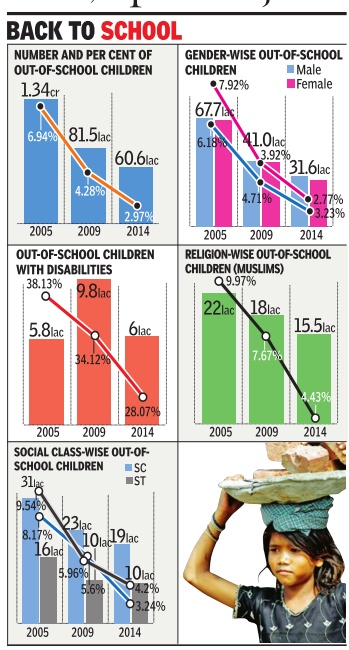Literacy: India
(→State-wise literacy, 2011) |
(→State-wise literacy, 2011) |
||
| Line 72: | Line 72: | ||
=Statistics, state-wise= | =Statistics, state-wise= | ||
| + | ==State-wise literacy, 1951-2001== | ||
| + | [http://indiabudget.nic.in/es2006-07/chapt2007/tab94.pdf India Budget.nic.in] | ||
| + | |||
| + | ===Notes=== | ||
| + | 1. Literacy rates for 1951, 1961 and 1971 Censuses relate to population aged five years and above. The rates for the 1981, 1991 and 2001 Censuses relate to the population aged seven years and above. The literacy rate for 1951 in case of West Bengal relates to Total population including 0-4 age group. Literacy rate for 1951 in respect of Chhatisgarg, Madhya Pradesh and Manipur are based on sample population. | ||
| + | |||
| + | 2. India and Manipur figures exclude those of the three sub-divisions viz. Mao Maram, Paomata and Purul of Senapati district of Manipur as census results of 2001 in these three sub-divisions were cancelled due to technical and administrative reasons. | ||
| + | |||
| + | 3. N.A. - Not available as no census was carried out in Assam during 1981 and in Jammu & Kashmir during 1991. | ||
| + | |||
| + | 4. Created in 2001. Uttaranchal Pradesh, Jharkhand and Chattisgarh for 1981 and 1991 are included under Uttar Pradesh, Bihar and Madhya Pradesh respectively. | ||
| + | |||
| + | Source: Office of the Registrar General, India | ||
| + | |||
==State-wise literacy, 2011== | ==State-wise literacy, 2011== | ||
Source: [http://www.census2011.co.in/states.php Census 2011] | Source: [http://www.census2011.co.in/states.php Census 2011] | ||
Revision as of 22:49, 20 December 2017
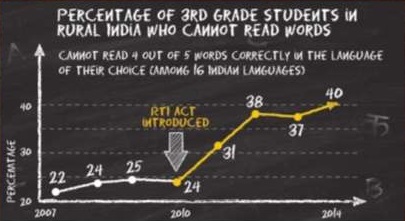
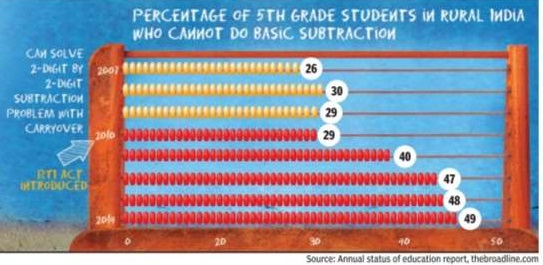
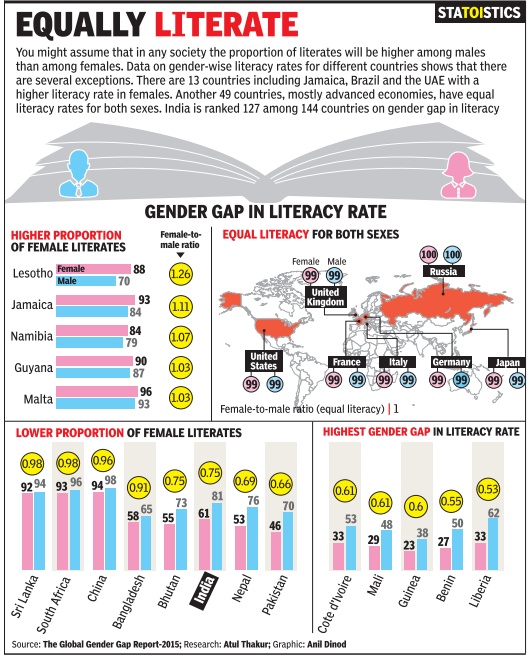
This is a collection of articles archived for the excellence of their content. Readers will be able to edit existing articles and post new articles directly |
Contents |
Dropout level, year-wise
Out-of-school children: 2009-2014
RTE effect: 26% drop in number of out-of-school kids since 2009
Akshaya Mukul
The Times of India Oct 14 2014
In a vindication of sorts for the Right to Education (RTE) Act, the latest HRD ministry-mandated survey shows a 26% drop in out-of-school children in the country since 2009.
According to the latest survey conducted by Indian Market Research Bureau for the ministry , out-of-school (OoS) children have declined to 60.6 lakh -2.97% of all children in the 6-14 age group -from 81.5 lakh in 2009. The first survey in 2005 found 1.34 crore out of school.
There were less girls (28.9 lakh) out of school than boys (31.7 lakh). In fact, girls have done better than boys in all three surveys.
A survey of OoS slum children was done for the first time and their number was found to be 4.73 lakh.
The survey found a continuing drop in the number of OoS children among Scheduled Castes and Muslims. Among tribal OoS children, the drop was marginal -from 10.69 lakh in 2009 to 10.07 lakh in 2014. In terms of social classes, the number of SC out-ofschool (OoS) children have come down to 19.66 lakh from 23.08 lakh in 2009 and 31.04 lakh in 2005.
In the latest survey found there were 15.57 lakh Muslim OoS children, down from 18.75 lakh in 2009 and 22.53 lakh in 2005.
While states such as Andhra Pradesh, Assam, Bihar, Jharkhand, Maharashtra, Delhi, Odisha, Rajasthan, Uttar Pradesh and West Bengal witnessed a decline in the OoS children, in 13 states and Union Territories percentage of such children has increased since 2009.
These include Gujarat, Karnataka, Kerala, Chhattisgarh, Punjab, Madhya Pradesh, Tamil Nadu and Uttarakhand.
What dampens the good work of RTE is that the decline in OoS disabled children has followed a different trajectory.
In 2005, 5.82 lakh disabled children were out of school which went up to 9.88 lakh in 2009 and in the latest round has come down to 6 lakh. Sources said it could be due to inclusion of more kinds of mental and physical disabilities in the list so that RTE becomes more inclusive. But there is a general acknowledgement that a lot needs to be done on this front.
January-July 2014: Dropout level
The Times of India, Jul 06 2015

Mahendra Singh
`11% of rural, 6% of urban people under 30 never went to schools'
Around 11% of those between 5-29 years of age in rural areas and 6% in urban areas never went to any educational institution, reveals an NSSO survey conducted between January and July , 2014. The students of the same age group who dropped out were around 33% in rural areas and 38% in urban areas. The survey has highlighted that the proportion of dropouts and `never enrolled' students depended on the living standards of households.The dropout rate was low in case of families with higher usually monthly per capita consumer expenditure (UMPCE). It was found that the proportion of the `never enrolled' category fell steeply from nearly 16% in the poorest households to only 6% among the richest in rural areas. In urban India, too, the percentage dropped from 12% to 1% from the bottom to the top class of households.
The survey found that the proportion of `never enrolled' persons in early 2014 had reduced by around 30% as compared to 2007-08.
However, it noted that the overall picture for proportion of dropouts, both in rural and urban areas, had not changed significantly over time as well as over UMPCE classes.
The survey revealed that the major reason for non-enrolment in rural areas was `not interested in education' (33% male and 27% female) while in urban areas, nearly 33% males and 30% females in the age group 5-29 years never enrolled because of `financial constraints'. The most common reason for dropping out for males was engagement in economic activities (30% in rural areas and 34% in urban areas), whereas for the females, the dominant reason was engagement in domestic activities (33% in rural areas and 23% in urban areas).
It noted marriage as second major reason for females (17%) to leave education in urban areas. The survey found that in rural areas, dropouts were mostly in the age-group of 5-15 years for both males and females. In contrast, in urban areas most dropout were in the age-group of 16-24 years.
Statistics, state-wise
State-wise literacy, 1951-2001
Notes
1. Literacy rates for 1951, 1961 and 1971 Censuses relate to population aged five years and above. The rates for the 1981, 1991 and 2001 Censuses relate to the population aged seven years and above. The literacy rate for 1951 in case of West Bengal relates to Total population including 0-4 age group. Literacy rate for 1951 in respect of Chhatisgarg, Madhya Pradesh and Manipur are based on sample population.
2. India and Manipur figures exclude those of the three sub-divisions viz. Mao Maram, Paomata and Purul of Senapati district of Manipur as census results of 2001 in these three sub-divisions were cancelled due to technical and administrative reasons.
3. N.A. - Not available as no census was carried out in Assam during 1981 and in Jammu & Kashmir during 1991.
4. Created in 2001. Uttaranchal Pradesh, Jharkhand and Chattisgarh for 1981 and 1991 are included under Uttar Pradesh, Bihar and Madhya Pradesh respectively.
Source: Office of the Registrar General, India
State-wise literacy, 2011
Source: Census 2011
|
State |
Literacy %age |
|
India |
74.04 |
|
Kerala |
94.00 |
|
Lakshadweep |
91.85 |
|
Mizoram |
91.33 |
|
Goa |
88.70 |
|
Tripura |
87.22 |
|
Daman and Diu |
87.10 |
|
Andaman and Nicobar Islands |
86.63 |
|
Delhi |
86.21 |
|
Chandigarh |
86.05 |
|
Puducherry |
85.85 |
|
Himachal Pradesh |
82.80 |
|
Maharashtra |
82.34 |
|
Sikkim |
81.42 |
|
Tamil Nadu |
80.09 |
|
Nagaland |
79.55 |
|
Uttarakhand |
78.82 |
|
Gujarat |
78.03 |
|
Manipur |
76.94 |
|
West Bengal |
76.26 |
|
Dadra and Nagar Haveli |
76.24 |
|
Punjab |
75.84 |
|
Haryana |
75.55 |
|
Karnataka |
75.36 |
|
Meghalaya |
74.43 |
|
Orissa |
72.87 |
|
Assam |
72.19 |
|
Chhattisgarh |
70.28 |
|
Madhya Pradesh |
69.32 |
|
Uttar Pradesh |
67.68 |
|
Jammu and Kashmir |
67.16 |
|
Andhra Pradesh |
67.02 |
|
Jharkhand |
66.41 |
|
Rajasthan |
66.11 |
|
Arunachal Pradesh |
65.38 |
|
Bihar |
61.80 |
Kerala
The Hindu, November 9, 2016
Move to educate migrant workers in most literate State
Kerala government will teach them to read and write in Hindi and Malayalam, besides creating legal awareness.
The sense of alienation that migrant workers in Kerala feel will come down substantively if the efforts of the Kerala State Literacy Mission Authority (KSLMA) prove a success.
The KSLMA is all set to launch a social literacy drive to integrate migrant labourers into Kerala society, by imparting reading and writing skills to them and to orient them to the culture of the State. A large majority of the 25 lakh migrant labourers in the State, many of whom hail from North India, are illiterate even in their mother tongue, according to KSLMA. As a result, they are ignorant in legal, health and environmental matters, resulting in poor quality of living as well as exploitation by their employers. This leads to gaps in their social relations with the locals.
"Our effort is to give them minimum language skill so that they are able to interact better with their hosts," says KSLMA director P.S. Sreekala. The workers, who contribute heavily to the State's development, were being “ostracised.” The literacy programme aimed at solving this issue by teaching them to read and write in Malayalam as well as Hindi, apart from introducing them to the social and cultural features of the State, and creating legal and health-related awareness, she said.
KSLMA is initiating three other programmes this year, including a continuing education mission for members of the trans-gender community, an environmental literacy mission and a functional literacy drive, aimed at the coastal areas of Kasaragod, Malappuram and Thiruvananthapuram.
Statistics, year-wise
Literacy in 2006
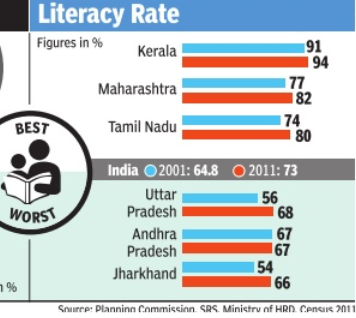
India has 37% of world's illiterate adults
IANS| Jan 29, 2014
India has by far the largest population of illiterate adults — 287 million or 37 per cent of the global total, according to the "EFA Global Monitoring Report, 2013-14: Teaching and Learning: Achieving quality for All." Commissioned by Unesco, it said that 10 countries (including India) account for 557 million or 72 per cent of the global population of illiterate adults.
"India's literacy rate rose from 48 per cent in 1991 to 63 per cent in 2006, (the latest year for which data was available), but population growth cancelled the gains. So there was no change in the number of illiterate adults," the report said.
Though India has more than 99 per cent children in schools because of the Right to Education Act, the quality of education being imparted is a big challenge that should be addressed, a top Unesco officer said.
The report also said that a global learning crisis was costing governments $129 billion a year, and that 10 per cent of global spending on primary education was being lost on poor quality education that was failing to ensure that children learn.
"It leaves one in four young people in poor countries unable to read a single sentence, affecting one-third of young women in South and West Asia," it said.
The countries include Bhutan, India, Bangladesh, Sri Lanka and Afghanistan.
2011: Literacy rate 74.4%
The Times of India, January 28, 2016
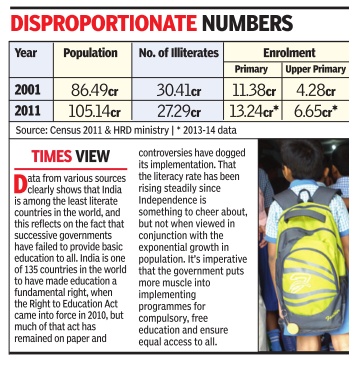
Chethan Kumar Literacy rate up, but so is illiteracy
Population Rising But Enrolment Not Keeping Pace
The overall literacy rate in the country may have gone up to 74.4%, but the drop in the illiteracy rate has not matched the increase in population. Between 2001 and 2011, the population above the age of 7 grew by 18.65 crore but the decrease in the number of illiterates is just 3.11 crore.
A 2015 Unesco report said that in terms of absolute numbers, India -with 28.7 crore illiterates -was the country with the largest number of adults without basic literacy skills in 2010-11 compared to 2000-01 when it had 30.4 crore illiterates. The fact that illiteracy is not being tackled is evident from the enrolment rates in primary and upper primary schools. Over 12 years (2000-01 to 2013-14), the number of children who enrolled in primary schools increased by just 1.86 crore, and at the upper primary level by just over 2 crore.The population during this period, however, increased by more than 18 crore.
“Over the past few years, there has been a dip in the enrolment rate across the country compared to the growth in population,“ says A S Seetharamu, a former professor of the Institute of Social and Economic Change.
Going by 2011 Census data, most states, barring a few like Nagaland, have recorded an increase in population but the enrolment rate does not mirror that. The country also seems to be having a problem with retaining people in schools and colleges. An average of 326 out of 1,000 students in rural areas are dropping out, while the same is 383 per 1,000 in urban areas, the National Sample Survey Organisation's (NSSO) last survey reveals. This data counts people up to the age of 29.
UNESCO has put the number of out-of-school (OOS) children at 17 lakh in India.A survey commissioned by the Centre put the number for 2014 at 61lakh, with SC and ST children making up 49.03% (29.73 lakh) of these.
2011: the most and least literate states
See graphic. : Literary rate, 2011, Bihar and Kerala and other states having highest and lowest adult literacy, respectively, 2011
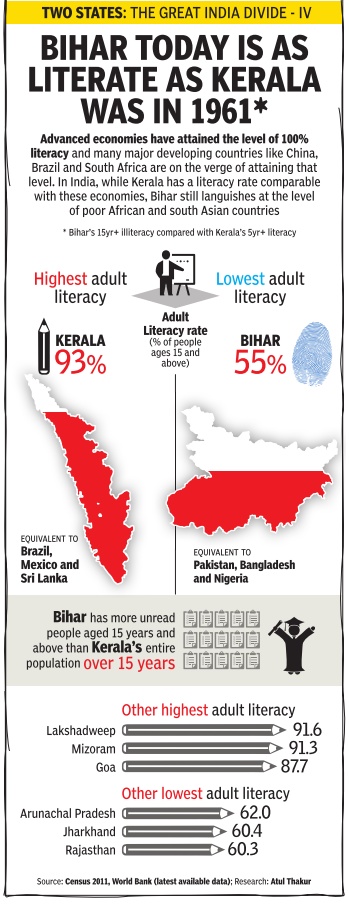
2017: Literacy rate, youth
See graphic: Youth Literacy Rate as in August 2017
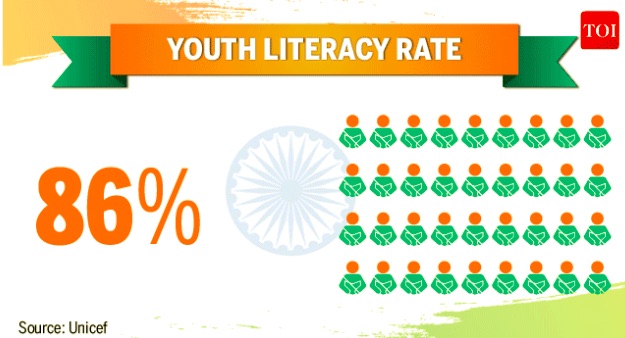
Statistics, India and the world
2015: India 2nd most `ignorant' among 33 nations
The Times of India, Dec 07 2015
India 2nd most `ignorant' nation, Mexico 1st: Study
India has the dubious honour of being the second most ignorant nation in the world after Mexico, according to a survey which posed questions on issues like inequality , non-religious population, female employment and internet access. The survey conducted by Ipsos MORI, a London-based market research firm, polled 25,000 people from 33 countries and found that while people “overestimate what we worry about“, a lot of major issues are underestimated.
“Mexico and India receive the dubious honour of being the most inaccurate in their perceptions on these issues, while South Koreans are the most accurate, followed by the Irish,“ the survey said.
The rankings of the nations were based on the “index of ignorance“ which was determined by questions about wealth that the top 1% own, obesity , non-religious population, immigration, living with parents, female employment, rural living and internet access.
Most Indians “underestimate“ how much of the country's wealth is concentrated in the hands of the top 1%, the survey said, adding that the top 1% actually own an “incredible“ 70% of all wealth.
The survey also found that most Indians “hugely overestimate“ the proportions of non-religious people in the country to be 33% when the true figure is under 1%.
While Israel significantly underestimates the proportion of female employment (by 29 percentage points), people in countries like India, Mexico, South Africa and Chile all think of more women in work than really are, it said.India fell in the list of nations which overestimate representation by women in politics.
Countries like Columbia, Russia, India and Brazil all think there is better female representation than there really is, the survey said.
However, the Indian population seriously underestimates the rural population of the country and thinks more people have internet access than in reality .
In India, the average guess among online respondents for internet access is 60% -an overestimation of the true picture of 41 percentage points, the survey added.
